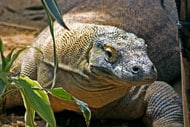Description:
This huge lizard is totally impractical to be kept in captivity except by zoos and other institutions that can provide solidly-built, escape-proof pens with a minimum of 1,000 square feet devoted to each specimen. The Komodo dragon’s powerful claws are capable of ripping caging apart if the construction is anything other than steel or concrete. Just the soaking pool required for the Komodo dragon is larger than most cages in the private sector. Besides the extraordinary housing requirements, Komodo dragons consume huge amounts of meat. Their bites are dangerous due to thick sharp teeth and a bacteria culture in their mouths that greatly increases the likelihood of infection after a bite. Some research has suggested, however, that the Komodo monitor may indeed use venom, and not bacteria, to subdue prey. Enjoy these beasts at the zoo, not at home. .
Habitat:
Open savannahs and woodlands
Range:
Komodo and a couple nearby islands in Indonesia
Scientific Name: Varanus komodoensis
Species Group: monitor
Family: Varanidae
Size: 4 to 10 feet long
Level:
Weight:
Dangerous: No


